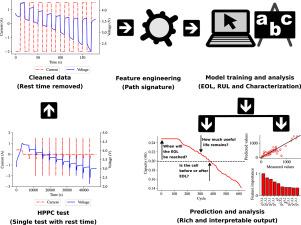利用脉冲测试数据进行基于路径特征的锂离子电池寿命预测
IF 10.1
1区 工程技术
Q1 ENERGY & FUELS
引用次数: 0
摘要
预测锂离子电池寿命(EOL)和剩余使用寿命(RUL)的常见模型需要使用长周期数据样本。当需要进行决策预测但又没有历史数据时,这是一个瓶颈。本文提出了一种机器学习模型,仅使用单次混合脉冲功率表征(HPPC)测试中的数据来预测锂离子电池的 EOL 和 RUL。该模型忽略了电池之前的循环使用情况,并在九个不同的数据集上进行了验证,每个数据集都有其阴极化学成分。此外,还开发了一种模型,能够根据 HPPC 测试对电池是否通过 EOL 进行分类。以数据为中心的特征生成建模概念是 "路径签名 "概念,它与基于树的可解释机器学习模型相结合,并对模型进行了深入研究。不同 SOC 范围的模型验证表明,从 HPPC 测试中收集的 20% SOC 窗口数据足以进行有效预测。EOL 和 RUL 模型的 MAE 分别为 85 和 91 个周期,而分类模型在测试数据上的准确率为 94%。数据处理和建模代码已公开发布。本文章由计算机程序翻译,如有差异,请以英文原文为准。

Path signature-based life prognostics of Li-ion battery using pulse test data
Common models predicting the End of Life (EOL) and Remaining Useful Life (RUL) of Li-ion cells make use of long cycling data samples. This is a bottleneck when predictions are needed for decision-making but no historical data is available. A machine learning model to predict the EOL and RUL of Li-ion cells using only data contained in a single Hybrid Pulse Power Characterization (HPPC) test is proposed. The model ignores the cell’s prior cycling usage and is validated across nine different datasets each with its cathode chemistry. A model able to classify cells on whether they have passed EOL given an HPPC test is also developed. The underpinning data-centric modelling concept for feature generation is the notion of ‘path signature’ which is combined with an explainable tree-based machine learning model and an in-depth study of the models is provided. Model validation across different SOC ranges shows that data collected from the HPPC test across a 20% SOC window suffices for effective prediction. The EOL and RUL models achieve 85 and 91 cycles MAE respectively while the classification model has an accuracy of 94% on the test data. Code for data processing and modelling is publicly available.
求助全文
通过发布文献求助,成功后即可免费获取论文全文。
去求助
来源期刊

Applied Energy
工程技术-工程:化工
CiteScore
21.20
自引率
10.70%
发文量
1830
审稿时长
41 days
期刊介绍:
Applied Energy serves as a platform for sharing innovations, research, development, and demonstrations in energy conversion, conservation, and sustainable energy systems. The journal covers topics such as optimal energy resource use, environmental pollutant mitigation, and energy process analysis. It welcomes original papers, review articles, technical notes, and letters to the editor. Authors are encouraged to submit manuscripts that bridge the gap between research, development, and implementation. The journal addresses a wide spectrum of topics, including fossil and renewable energy technologies, energy economics, and environmental impacts. Applied Energy also explores modeling and forecasting, conservation strategies, and the social and economic implications of energy policies, including climate change mitigation. It is complemented by the open-access journal Advances in Applied Energy.
 求助内容:
求助内容: 应助结果提醒方式:
应助结果提醒方式:


